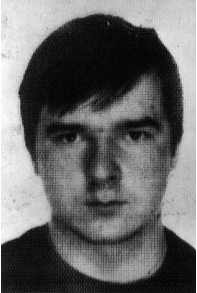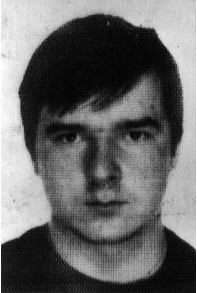
Tuesday 19th April 2016
The inquest resumes after expert testimony last Friday when 2 witnesses confirmed that Pearse Jordan must have been shot in the back; a significant rebuttal to the killer’s assertion that the victim was facing him with one hand holding the other wrist, as if he was holding a revolver.
Pearse Jordan was 23 years old when he was shot and killed; he died just after 5pm on November 25th 1992. The killer was an RUC HQ Mobile Support Unit sergeant, known only as Officer A. The coroner, Mr Justice Mark Horner, has been hearing the evidence without a jury. He brings a fresh view to the inquest – his background is in commercial law – so his findings will be watched with interest. One important decision he made at the start of proceedings was that, notwithstanding the fact that many of the RUC personnel have hidden behind anonymity and screening, Pearse’s parents were placed in the body of the court so that they could see the officers on the witness stand and judge their bearing and demeanour. Whatever the final outcome, Theresa and Hugh Jordan have been able to look into the officers’ faces as they recounted their role the operation which lead to their son’s death.
Today, three RUC officers have called back to the stand to be asked about a document disclosed very late, just before the end of the inquest. This document related to intelligence received in the Operations Room on the afternoon Pearse Jordan was killed. Specifically, a named suspect had been seen in the area acting suspiciously. This suspect was known to be a senior IRA activist who had a record with explosives and weapons. The officers today were being asked whether the name of this individual was heard by their unit on the ground as they prepared to stop the suspect car.
Needless to say, all three officers called today say that they “cannot recall” hearing the name on the day. The question as to whether the named was not made known to them or simply that they “cannot recall” was explored with each.
Essentially the issue is whether the officers thought, when they confronted Pearse Jordan, that the suspect named in this new document was in the car. Thus, was Pearse shot deliberately because they thought he was a known IRA activist; this was the “cock-up” scenario reported in the media in the days following the shooting.
While the officers all say they can’t recall the name or whether it was mentioned, some acknowledge under questioning that this is indeed the type of information they would normally expect to receive on such an operation. They also have to acknowledge that the individual does seem to be a senior IRA activist.
The charade is repeated three times, with officers B, C and F. After all cover ups don’t work if people depart from the script.
One officer (B) took some time on the issue of whether they would normally be given such information, though he was forced to equivocation under questioning by counsel for the family and by the coroner. Indeed the coroner seemed rather surprised by this officer’s claims that such information would not be relevant to officers on the ground. The coroner also seemed surprised that an individual with this profile was not known to the officers, as claimed by at least two of them.
This marathon inquest is finally winding up. An earlier inquest had been quashed because the jury could come to a decision on key points. This case has created much of the case law which now underpins the more effective inquest system which is now in operation; with proper discovery to the victims’ family; proper consideration of all relevant factors rather than a narrow focus on the moments of death; equality of arms through legal aid for family solicitors and barristers; the requirement of security personnel to attend and give evidence.
It will be an historic moment when the inquest is over. Written submissions – when parties set out their assessment of all the evidence – are now to be completed for 6th May. Closing oral submissions – when parties can respond to each others’ written conclusions and the coroner can seek any final clarifications – will be heard on 13th May, Thereafter, the coroner will retire to write up his findings. If he considers that criminal offences may have been committed, he must refer the matter to the Director of Public Prosecutions, Barra McGrory, QC.









